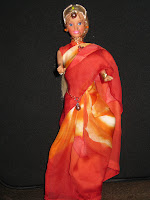Have you ever wonder how many things one can learn while seconds, minutes, days, months... years, etc., keep on passing? One can never learn enough! That's what I believe. According to a Buddhist Proverb: When the student is ready, the master appears... and so was I for my first Karnatac Music Lesson (also called Carnatic music).
For some of you who are not aware of the term Carnatic Music and/or Karnatac Music is the classical music of South India. In India you can find two types of music: the classical Carnatic music and the Hindustani music which was developed in the northern part of the Indian subcontinent.
Carnatic music is exclusively devotional due to the fact that most of the songs are addressed to the Hindu Deitis. Performing a dance with Karnatic music - in other words performing a bharatnatyam piece of dance its offered as a religious service.
The basics of Karnatac music:
One of the two main components is 'raaga'. A 'raaga' is essentially the 'music' (a raaga can be defined as patterns basically used in the Indian classical music). The second main component is the Talam which is more or less a rythmic cycle. Carnatic music also makes use of a Sruti which is a sort of background music from which the note from all other different tones are derived. The solfege in Carnatic music is "sa-ri-ga-ma-pa-da-ni" and each member of the solfege is called 'swara'.
A particular characteristic in Carnatic music is the Talam which the singers keep on performing by beating with their hand their lap. Those beats are the rythmic cycles formed with three basic movements: lowering the palm of the nad into the thigh, lowering a specified number of fingers in a sequence starting from the little finger, and turning the hand over. This basic hand and finger movements are group into three units:
-The laghu where the palm is lowered and then the fingers.
-The dhrtam where the palm is lowered in first place and then turned over.
-The anudhrtam where only the palm is lowered.
These three units are being used while performing the Talam - rythmic cycle. Seven types of can be found:
-Dhruva talam (formed of laghu,dhrtam, laghu and laghu)
-Matya talam (formed of laghu, dhrtam and laghu)
-Rupaka talam (formed of dhrtam and laghu)
-Jhampa talam (formed of laghu, anudhrtam and dhrtam)
-Triputa talam (formed of laghu, dhrtam and dhrtam)
-Ata Talam (formed of laghu, laghu, dhrtam dhrtam)
-Eka talam (only formed of a laghu)
Once I was aware of the basics and components of Karnatac music, I proceed by reading the swaras. I read each swara around 10 times to get familiar to the way how it is pronunce and chant. From first glance I thought it would be easy, it started become more and more difficult once I was asked to chant them... and yeah! I needed to chant them exactly the way the 'lecturer' was doing. The first times we chant them on a slow tempo... with the time the tempo started increasing... there were times I was left out of breathe...
But, the fun wasnt yet started, it only started namely when I was asked to perform the Talam (this was the Adi-Talam: one of the most common Talams used in Karnatac music) while chanting. Wow! that was really complicated. I got either lost in the chanting or in the beating... Finally, I manage to sort of chant and beat at the same time... (what a though job I would say... and mostly when I felt all the time out of breathe ... ;-))
We proceed by chanting new excercises and examples.... the difficult arose even more when the exercise of Jaintai Varisaigal came into picture. This exercise consisted of repeating each 'swara' two times; eg.:
sasa-riri-gaga-mama-papa-dada-nini... Personally I found this exercise a bunch of fun... while practicing I ended up forming words like pipi, baba, mami, nani, nina, etc... ;-) try it out :-)
So that's it for now... I will have to keep on practicing... and yeah I will have to practice the chanting... for how long???? Who knows... We'll see!
-----------------------------
This is an example of a Sruti (this was the one we used for practicing):

The Talam (rythmic cycle-most commonly used: Adi-Talam-composed of 8 beats):










